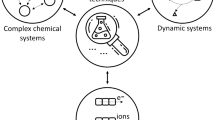Abstract
A new approach to the research of supramolecular complexes by the AFM method and the possible role of hydrogen bonds in the formation of nanostructures of metal complexes simulating the active centers of enzymes was proposed. The formation of these structures occurs due to non-covalent intermolecular interactions, and to a certain extent reflects the structure of the complexes involved in the mechanisms of homogeneous and enzymatic catalysis, as well as during morphological changes of cells.



Similar content being viewed by others
REFERENCES
Atomic Force Microscopy for Materials, Microscopy EKB Ser., Ed. by J. Heath, Spectroscopy and Separations EKB Ser., Ed. by N. Taylor (Wiley, Chichester, UK, 2017).
A. G. Slater, L. M. A. Perdigão, P. H. Beton, et al., Acc. Chem. Res. 47, 3417 (2014)
F. Biedermann and H.-J. Schneider, Chem. Rev. 116, 5216 (2016)
L. I. Matienko, V. I. Binyukov, L. A. Mosolova, et al., Chem. Chem. Tech. 8, 339 (2014).
L. I. Matienko, L. A. Mosolova, and G. E. Zaikov, Selective Catalytic Hydrocarbons Oxidation.New Perspectives (Nova Science, New York, USA, 2010).
L. I. Matienko and L. A. Mosolova, Oxid. Commun. 37, 20 (2014)
L. I. Matienko, V. I. Binyukov, L. A. Mosolova, et al., Oxid. Commun. 40, 569 (2017).
A. R. Deshpande, Th. C. Pochapsky, and D. Ringe, Chem. Rev. 117, 10474 (2017).
St. Leitgeb, G. D. Straganz, and B. Nidetzky, FEBS J. 276, 5983 (2009).
L. I. Matienko, V. I. Binyukov, E. M. Mil, et al., Oxid. Commun. 41, 429 (2018).
I. P. Beletskaya, V. S. Tyurin, and A. Yu. Tsivadze, Chem. Rev. 109, 1659 (2009).
E. J. Basom, A. M. Bryce, and C. Th. Megan, Biochemistry 56, 3248 (2017).
V. I. Binyukov, E. M. Mil, I. V. Zhigacheva, A. A. Albantova, I. P. Generozova, A. G. Shugaev, S. G. Fattakhov, and A. I. Konovalov, Dokl. Biochem. Biophys. 446, 220 (2012).
E. M. Mil, V. I. Binyukov, I. V. Zhigacheva, et al., VTU (Kazan), No. 3, 141 (2013)
E. M. Mil and V. N. Erokhin, Bull. Exp. Biol. Med. 164, 673 (2018). https://doi.org/10.1007/s10517-018-4056-3
Funding
The work was supported by the PFR RAS 14P, NIOKTR Number: AAAA-A17-117121920169-0.
Author information
Authors and Affiliations
Corresponding author
Rights and permissions
About this article
Cite this article
Matienko, L.I., Mil, E.M. & Binyukov, V.I. AFM Research of Supramolecular Structures. Russ. J. Phys. Chem. B 14, 559–563 (2020). https://doi.org/10.1134/S1990793120030227
Received:
Revised:
Accepted:
Published:
Issue Date:
DOI: https://doi.org/10.1134/S1990793120030227




